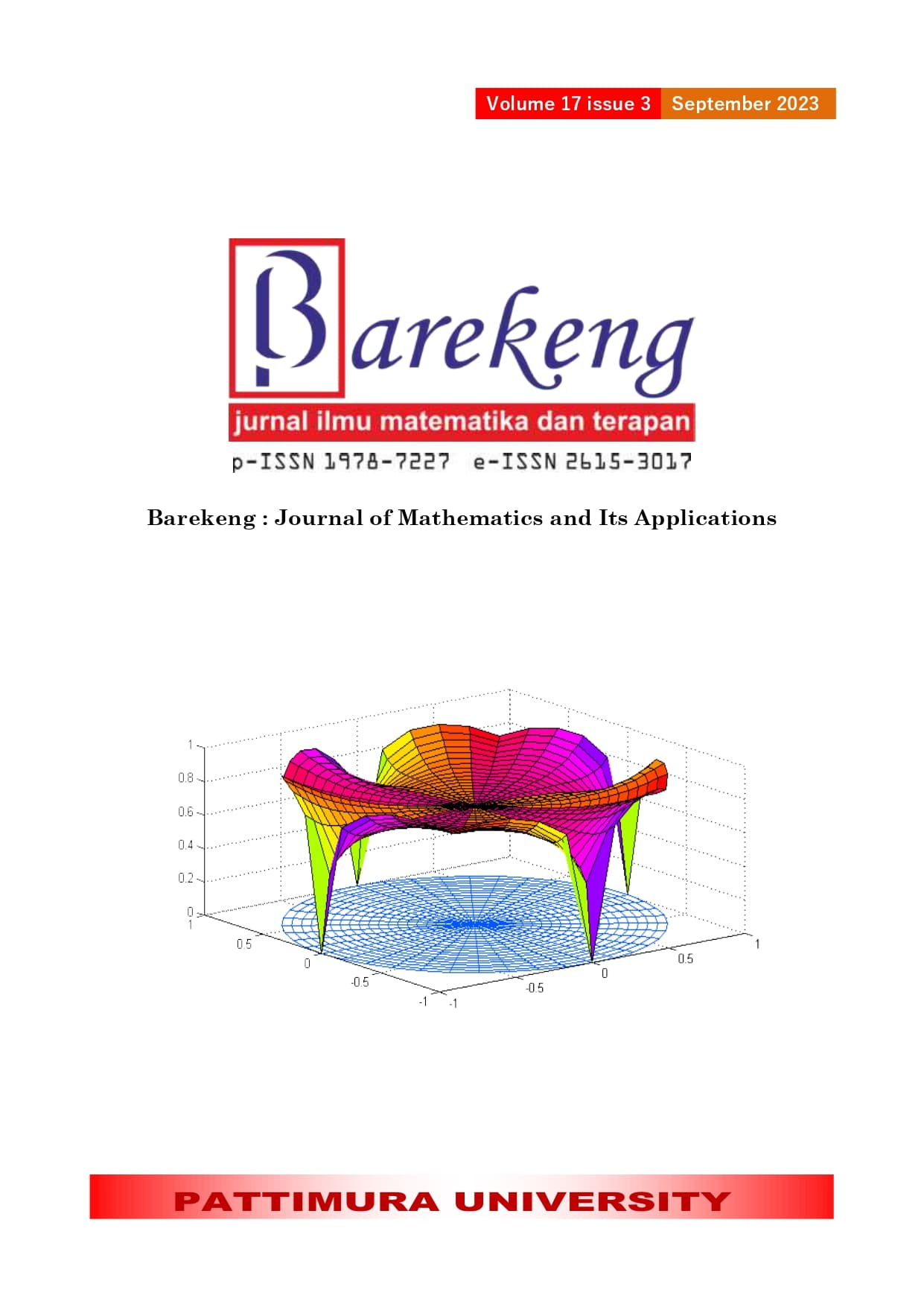RAINFALL PREDICTION IN JEMBER REGENCY WITH ADAPTIVE NEURO FUZZY INFERENCE SYSTEM BASED ON GSMaP SATELLITE DATA
Abstract
Rainfall is very influential in daily life, including in agriculture. According to the Jember Regency Government, the majority of the economic activities of the Jember people come from the agricultural sector. Significant changes in rainfall conditions will adversely affect the agricultural sphere. The Water Resources Office of Jember Regency measures rainfall directly. Precipitation measurement can also be made indirectly using the Global Satellite Mapping of Precipitation (GSMaP), a project promoted by the Japan Aerospace Exploration Agency (JAXA) to produce rainfall accumulation globally. Rainfall predictions are urgently needed to address rainfall-related issues. The Adaptive Neuro-Fuzzy Inference System (ANFIS) method is an effective method for prediction because its working principle combines adaptive methods of artificial neural networks and fuzzy logic. The RMSE in the ANFIS training and testing process on daily rainfall was 12.7464 and 14.6268. Furthermore, RMSE in ANFIS training and testing on monthly rainfall was 7.6336 and 8.1456. The predicted daily rainfall in Jember Regency on January 1, 2023, is 3.1971 mm. Meanwhile, the predicted monthly rainfall in Jember Regency in January 2023 is 19.9114 mm.
Downloads
References
Badan Meteorologi Klimatologi dan Geofisika, Climate Outlook 2023. Jakarta: Badan Meteorologi Klimatologi dan Geofisika, 2022.
Dinas Komunikasi dan Informatika Kabupaten Jember, “Geografis dan Topografi,” 2021. https://www.jemberkab.go.id/selayang-pandang/geografis-dan-topografi/ (accessed Jan. 23, 2023).
T. Kubota et al., “Global Satellite Mapping of Precipitation (GSMaP) Products in the GPM Era,” 2020, pp. 355–373. doi: 10.1007/978-3-030-24568-9_20.
I. G. A. M. Duwanda and I. K. Sukarasa, “Validation of Daily Rainfall Based on Global Satellite Mapping Of Precipitation (Gsmap) Data with Observation Data in The Bali Region,” BULETIN FISIKA, vol. 23, no. 2, p. 106, Aug. 2021, doi: 10.24843/BF.2022.v23.i02.p05.
Sumila, “Validasi Curah Hujan Satelit GSMaP Pada Data Curah Hujan Aktual Kabupaten Jember,” University of Jember, Jember, 2022.
T. Fatyanosa and W. Mahmudy, “Implementation of Real Coded Genetic Fuzzy System for Rainfall Forecasting,” in International Conference on Sustainable Information Engineering and Technology (SIET), International Conference on Sustainable Information Engineering and Technology (SIET), Oct. 2016, pp. 24–33.
I. Wahyuni, W. F. Mahmudy, and A. Iriany, “Rainfall prediction in Tengger region Indonesia using Tsukamoto fuzzy inference system,” in 1st International Conference on Information Technology, Information Systems and Electrical Engineering (ICITISEE), IEEE, Aug. 2016, pp. 130–135. doi: 10.1109/ICITISEE.2016.7803061.
I. Wahyuni and W. F. Mahmudy, “Rainfall Prediction in Tengger, Indonesia Using Hybrid Tsukamoto FIS and Genetic Algorithm Method,” Journal of ICT Research and Applications, vol. 11, no. 1, pp. 38–55, Apr. 2017, doi: 10.5614/itbj.ict.res.appl.2017.11.1.3.
I. Wahyuni, W. F. Mahmudy, and A. Iriany, “Rainfall Prediction Using Hybrid Adaptive Neuro Fuzzy Inference System (ANFIS) and Genetic Algorithm,” Journal of Telecommunication, Electronic and Computer Engineering (JTEC), vol. 9, no. 2–8, pp. 51–56, Sep. 2017, [Online]. Available: https://jtec.utem.edu.my/jtec/article/view/2627
N. Triana, “Sistem Pakar Diagnosa Penyakit Pada Tanaman Seledri Menggunakan Metode ANFIS ,” TIN: Terapan Informatika Nusantara, vol. 1, no. 8, pp. 418–423, 2021.
R. Janarthanan, R. Balamurali, A. Annapoorani, and V. Vimala, “Prediction of rainfall using fuzzy logic,” Mater Today Proc, vol. 37, pp. 959–963, 2021, doi: 10.1016/j.matpr.2020.06.179.
M. I. Azhar and W. F. Mahmudy, “Prediksi Curah Hujan Menggunakan Metode Adaptive Neuro Fuzzy Inference System (ANFIS),” Jurnal Pengembangan Teknologi Informasi dan Ilmu Komputer, vol. 2, no. 11, pp. 4932–4939, Jul. 2018, [Online]. Available: https://j-ptiik.ub.ac.id/index.php/j-ptiik/article/view/3139
S. A. Hardiyanti and Q. Shofiyah, “Prediksi Kasus COVID-19 Di Indonesia Menggunakan Metode Adaptive Neuro Fuzzy Inference System (ANFIS),” Prosiding Seminar Nasional Terapan Riset Inovatif (SENTRINOV), vol. 6, no. 1, pp. 974–981, Nov. 2020, [Online]. Available: https://proceeding.isas.or.id/index.php/sentrinov/article/view/569
D. Rahakbauw, Muh. Tanassy, and B. Tomasouw, “Sistem Prediksi Tingkat Pengangguran Di Provinsi Maluku Menggunakan ANFIS (Adaptive Neuro Fuzzy Inference System),” BAREKENG: Jurnal Ilmu Matematika dan Terapan, vol. 12, no. 2, pp. 99–106, Dec. 2018, doi: 10.30598/vol12iss2pp099-106ar621.
R. F. Rahmat, Nurmawan, S. Sembiring, M. F. Syahputra, and Fadli, “Adaptive neuro-fuzzy inference system for forecasting rubber milk production,” IOP Conf Ser Mater Sci Eng, vol. 308, p. 012014, Feb. 2018, doi: 10.1088/1757-899X/308/1/012014.
Y. T. Nugraha, K. Ghabriel, and I. F. Dharmawan, “Implementasi ANFIS Dalam Prakiraan Konsumsi Energi Listrik Di Kota Medan Pada Tahun 2030,” RELE (Rekayasa Elektrikal Dan Energi) : Jurnal Teknik Elektro, vol. 4, no. 1, pp. 55–59, 2021.
M. A. Raharja, I. D. M. B. A. Darmawan, D. P. E. Nilakusumawati, and I. W. Supriana, “Analysis of membership function in implementation of adaptive neuro fuzzy inference system (ANFIS) method for inflation prediction,” J Phys Conf Ser, vol. 1722, no. 1, p. 012005, Jan. 2021, doi: 10.1088/1742-6596/1722/1/012005.
I. P. Sedana Wijaya, M. Agung Raharja, L. A. Ayu Rahning Putri, I. P. G. Hendra Suputra, I. B. M. Mahendra, and I. G. Santi Astawa, “Penerapan Metode Adaptive Neuro Fuzzy Inference System (ANFIS) Dengan Membership function Tipe Gaussian dan Generalized Bell Dalam Prediksi Harga Tertinggi Saham,” JELIKU (Jurnal Elektronik Ilmu Komputer Udayana), vol. 11, no. 1, p. 111, Jul. 2022, doi: 10.24843/JLK.2022.v11.i01.p12.
Tarno, A. Rusgiyono, and Sugito, “Adaptive Neuro Fuzzy Inference System (ANFIS) approach for modeling paddy production data in Central Java,” J Phys Conf Ser, vol. 1217, no. 1, p. 12083, May 2019, doi: 10.1088/1742-6596/1217/1/012083.
Copyright (c) 2023 Abduh Riski, Wakhidatun Nafi’u Haqqi, Ahmad Kamsyakawuni

This work is licensed under a Creative Commons Attribution-ShareAlike 4.0 International License.
Authors who publish with this Journal agree to the following terms:
- Author retain copyright and grant the journal right of first publication with the work simultaneously licensed under a creative commons attribution license that allow others to share the work within an acknowledgement of the work’s authorship and initial publication of this journal.
- Authors are able to enter into separate, additional contractual arrangement for the non-exclusive distribution of the journal’s published version of the work (e.g. acknowledgement of its initial publication in this journal).
- Authors are permitted and encouraged to post their work online (e.g. in institutional repositories or on their websites) prior to and during the submission process, as it can lead to productive exchanges, as well as earlier and greater citation of published works.






1.gif)



